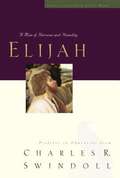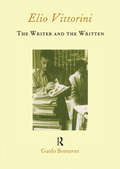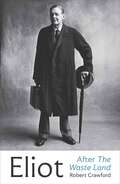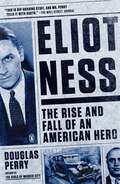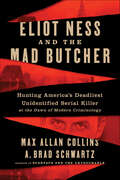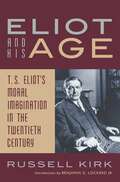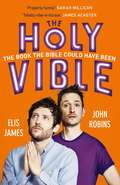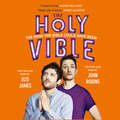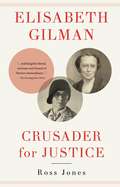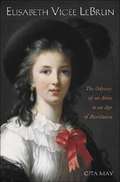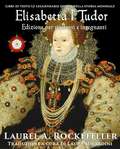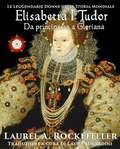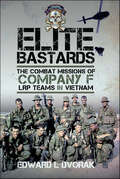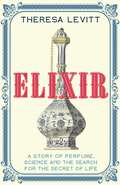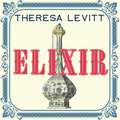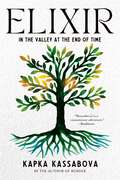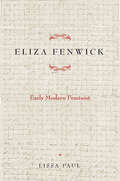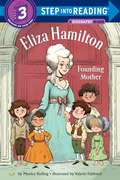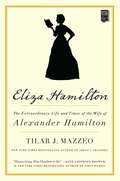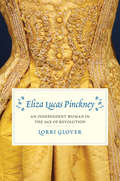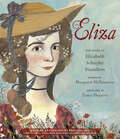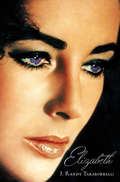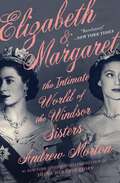- Table View
- List View
Elio Vittorini: The Writer and the Written
by Guido Bonsaver"Elio Vittorini holds a major position in 20th-century Italian literature thanks to both his narrative production and his activity as editor and militant intellectual. This work aims to present the English-speaking reader with a comprehensive study of the author, his times and his work. Particular attention has been paid to the interconnection between Vittorini's work as a fiction writer and his political commitment which saw him move from revolutionary fascism to communism, to independent left-wing militancy. The combination of extensive archival research with a re-appraisal of his fiction and of his editorial activity provides a full picture reaching beyond the traditional restricted view of Vittorini as the anti-fascist author of ""Conversazione in Sicilia""."
Eliot After "the Waste Land"
by Robert CrawfordThe second volume of Robert Crawford's magisterial biography of the revolutionary modernist, visionary poet and troubled man, drawing on extensive new sources. In this compelling and meticulous portrait of the twentieth century's most important poet, Robert Crawford completes the story he began in Young Eliot. Drawing on extensive new sources and letters, this is the first full-scale biography to make use of Eliot's most significant surviving correspondence, including the archive of letters (unsealed for the first time in 2020) detailing his decades-long love affair with Emily Hale. This long-awaited second volume, Eliot After 'The Waste Land', tells the story of the mature Eliot, his years as a world-renowned writer and intellectual, and his troubled interior life. From his time as an exhausted bank employee after the publication of The Waste Land, through the emotional turmoil of the 1920s and 1930s, and his years as a firewatcher in bombed wartime London, Crawford reveals the public and personal experiences that helped generate some of Eliot's masterpieces. He explores the poet's religious conversion, his editorship at Faber and Faber, his separation from Vivien Haigh-Wood and happy second marriage to Valerie Fletcher, and his great work Four Quartets. Robert Crawford presents this complex and remarkable man not as a literary monument but as a human being: as a husband, lover and widower, as a banker, editor, playwright and publisher, but most of all as an epoch-shaping poet struggling to make art among personal disasters.
Eliot Ness
by Douglas PerryThe true story of Eliot Ness, the legendary lawman who led the Untouchables, took on Al Capone, and saved a city's soul Eliot Ness is famous for leading the Untouchables against the notorious mobster Al Capone. But it turns out that the legendary Prohibition Bureau squad's daring raids were only the beginning. Ness's true legacy reaches far beyond Big Al and Chicago. Eliot Ness follows the lawman through his days in Chicago and into his forgotten second act. As the public safety director of Cleveland, he achieved his greatest success: purging the city of corruption so deep that the mob and the police were often one and the same. And it was here, too, that he faced one of his greatest challenges: a brutal, serial killer known as the Torso Murderer, who terrorized the city for years. Eliot Ness presents the first complete picture of the real Eliot Ness. Both fearless and shockingly shy, he inspired courage and loyalty in men twice his age, forged law-enforcement innovations that are still with us today, and earned acclaim and scandal from both his professional and personal lives. Through it all, he believed unwaveringly in the integrity of law and the basic goodness of his fellow Americans.
Eliot Ness
by Douglas PerryThe story of Eliot Ness, the legendary lawman who led the Untouchables, took on Al Capone, and saved a city's soulAs leader of an unprecedented crime-busting squad, twenty-eight-year-old Eliot Ness won fame for taking on notorious mobster Al Capone. But the Untouchables' daring raids were only the beginning of Ness's unlikely story.This new biography grapples with the charismatic lawman's complicated, largely forgotten legacy. Perry chronicles Ness's days in Chicago as well as his spectacular second act in Cleveland, where he achieved his greatest success: purging the profoundly corrupt city and forging new practices that changed police work across the country. He also faced one of his greatest challenges: a mysterious serial killer known as the Torso Murderer. Capturing the first complete portrait of the real Eliot Ness, Perry brings to life an unorthodox man who believed in the integrity of law and the power of American justice.acclaim and scandal from both his professional and personal lives. Through it all, he believed unwaveringly in the integrity of law and the basic goodness of his fellow Americans.
Eliot Ness and the Mad Butcher: Hunting America's Deadliest Unidentified Serial Killer at the Dawn of Modern Criminology
by Max Allan Collins A. Brad Schwartz"The thrilling history of the torso murderer. The tale of the ‘Untouchable’ who got Al Capone but failed to solve his goriest case." —Dan Jones, The Sunday TimesIn the spirit of Devil in the White City comes a true detective tale of the highest standard: the haunting story of Eliot Ness's forgotten final case–his years-long hunt for "The Mad Butcher of Kingsbury Run," a serial killer who terrorized Cleveland through the Great Depression. “After helping to put Al Capone behind bars, lawman Eliot Ness came to Cleveland, where he did battle with a vicious killer. ... Even Ness was stumped trying to apprehend the ‘torso murderer’ responsible for a series of ghoulish killings. ... The authors have done Ness justice." —Wall Street JournalIn 1934, the nation’s most legendary crime-fighter–fresh from taking on the greatest gangster in American history–arrived in Cleveland, a corrupt and dangerous town about to host a world's fair. It was to be his coronation, as well as the city's. Instead, terror descended, as headless bodies started turning up. The young detective, already battling the mob and crooked cops, found his drive to transform American policing subverted by a menace largely unknown to law enforcement: a serial murderer.Eliot Ness's greatest case had begun. Now, Max Allan Collins and A. Brad Schwartz–the acclaimed writing team behind Scarface and the Untouchable–uncover this lost crime epic, delivering a gripping and unforgettable nonfiction account based on decades of groundbreaking research.Ness had risen to fame in 1931 for leading the “Untouchables,” which helped put Chicago’s Al Capone behind bars. As Cleveland's public safety director, in charge of the police and fire departments, Ness offered a radical new vision for better law enforcement. Crime-ridden and devastated by the Depression, Cleveland was preparing for a star-turn itself: in 1936, it would host the "Great Lakes Exposition," which would be visited by seven million people. Late in the summer of 1934, however, pieces of a woman’s body began washing up on the Lake Erie shore–first her ribs, then part of her backbone, then the lower half of her torso. The body count soon grew to five, then ten, then more, all dismembered in gruesome ways.As Ness zeroed in on a suspect–a doctor tied to a prominent political family–powerful forces thwarted his quest for justice. In this battle between a flawed hero and a twisted monster–by turns horror story, political drama, and detective thriller–Collins and Schwartz find an American tragedy, classic in structure, epic in scope.
Eliot and His Age: T. S. Eliot's Moral Imagination in the Twentieth Century
by Russell KirkThough much has been written about T. S. Eliot since it was first published, Eliot and His Age remains the best introduction to the poet's life, ideas, and literary works. It is the essential starting place for anyone who would understand what Eliot was about. Russell Kirk's view of his older friend is sympathetic but not adulatory. His insights into Eliot's writings are informed by wide reading in the same authors who most influenced the poet, as well as by similar experiences and convictions. Kirk elaborates here a significant theory of literary meaning in general, showing how great literary works awaken our intuitive reason, giving us profound visions of truth that transcend logical processes. And he traces Eliot's political and cultural ideas to their true sources, showing the balance and subtlety of Eliot's views. Eliot and His Age is a literary biography that will endure when much of the more recent writing on Eliot is gathering dust.
Elis and John Present the Holy Vible: The Book The Bible Could Have Been
by Elis James John RobinsThe Elis James and John Robins' Show has become cult listening, and that cult has registered for charitable status, published quarterly accounts and been given a full blessing by the Archbishop of Broadcasting. It's official: Elis and John are a religion, and this book is their Holy Vible.Have you ever failed to Keep It Session? Is your new flatmate a complete coin? Have you ever eaten Space Raiders on the toilet and written 'Grief Is Living' in your journal? Then this book is for you. If not, don't worry, it won't be long before you're making up games, looking at Freddie, or facing your own personal farthing-gate.Our obsessions make us what we are, and though you may never have addressed a will to Brian May or cried watching Ronnie O' Sullivan make a 147, you'll have done something similar, and Elis and John are here to tell you that you're not weird, so come on in, and taste the vibe! Or should I say, READ the vibe!
Elis and John Present the Holy Vible: The Book The Bible Could Have Been
by Elis James John Robins'Elis and John are my go-to place when I need a bloody good laugh. Properly funny!' Sarah MillicanComedians Elis James and John Robins have captured the hearts and minds of a generation, and it's time those hearts and minds had a book.Elis and John met in 2005 performing stand-up comedy in a pub called The Yellow Kangaroo in Cardiff. They eyed each other suspiciously before Robins offered the limpest handshake in the history of the world.'It was a power play,' says Robins. 'I may even have raised it for him to kiss.' James expands: 'It was one of the weirdest things I'd ever experienced, but having known John now for over a decade, it was the tip of the iceberg. I can honestly say he's the oddest man I've ever met.'Little did they know that ten years later they would be presenting a radio show together that would make them comedy royalty...Ok, radio comedy royalty...Ok, commercial digital indie radio royalty...But with a podcast! Now, The Elis James and John Robins' Show has become cult listening, and that cult has registered for charitable status, published quarterly accounts and been given a full blessing by the Archbishop of Broadcasting. It's official: Elis and John are a religion, and this book is their Holy Vible.Have you ever failed to Keep It Session? Is your new flatmate a complete coin? Have you ever eaten Space Raiders on the toilet and written 'Grief Is Living' in your journal? Then this book is for you. If not, don't worry, it won't be long before you're making up games, looking at Freddie, or facing your own personal farthing-gate.Our obsessions make us what we are, and though you may never have addressed a will to Brian May or cried watching Ronnie O' Sullivan make a 147, you'll have done something similar, and Elis and John are here to tell you that you're not weird, so come on in, and taste the vibe! Or should I say, READ the vibe!
Elis and John Present the Holy Vible: The Book The Bible Could Have Been
by Elis James John Robins'Elis and John are my go-to place when I need a bloody good laugh. Properly funny!' Sarah MillicanComedians Elis James and John Robins have captured the hearts and minds of a generation, and it's time those hearts and minds had a book. Or an audiobook, that not only features extra nuggets and riffs that are too hot for the printed page, but also serves as an excellent showreel should you wish to book Elis or John for lucrative voice over work.Elis and John met in 2005 performing stand-up comedy in a pub called The Yellow Kangaroo in Cardiff. They eyed each other suspiciously before Robins offered the limpest handshake in the history of the world.'It was a power play,' says Robins. 'I may even have raised it for him to kiss.'James expands: 'It was one of the weirdest things I'd ever experienced, but having known John now for over a decade, it was the tip of the iceberg. I can honestly say he's the oddest man I've ever met.'Little did they know that ten years later they would be presenting a radio show together that would make them comedy royalty...Ok, radio comedy royalty...Ok, commercial digital indie radio royalty...But with a podcast! Now, The Elis James and John Robins' Show has become cult listening, and that cult has registered for charitable status, published quarterly accounts and been given a full blessing by the Archbishop of Broadcasting. It's official: Elis and John are a religion, and this book is their Holy Vible.Have you ever failed to Keep It Session? Is your new flatmate a complete coin? Have you ever eaten Space Raiders on the toilet and written 'Grief Is Living' in your journal? Then this book is for you. If not, don't worry, it won't be long before you're making up games, looking at Freddie, or facing your own personal farthing-gate.Our obsessions make us what we are, and though you may never have addressed a will to Brian May or cried watching Ronnie O' Sullivan make a 147, you'll have done something similar, and Elis and John are here to tell you that you're not weird, so come on in, and taste the vibe! Or should I say, READ the vibe!Read by Elis and John, and featuring bonus material and an exclusive introduction. (p) Orion Publishing Group 2018
Elisabeth Gilman: Crusader for Justice
by Ross JonesThis is the first biography of Elisabeth Gilman, a largely forgotten Marylander who was born to privilege in the nineteenth century but became an irrepressible force for social justice in the twentieth. As the second daughter of Daniel Coit Gilman, founding president of The Johns Hopkins University in Baltimore, Elisabeth was raised in well-to-do, influential circles. Privately educated by tutors, she eventually earned a bachelor's degree at Johns Hopkins. But unlike many who shared Elisabeth's elevated station, she was possessed of a restless and critical spirit. As a strong devotee of the Social Gospel, she campaigned on behalf of the poor, African- Americans, women, and laborers exposed to harsh conditions. After her father's death, Elisabeth joined the Socialist Party and was nominated as a candidate for governor of Maryland, United States senator, mayor of Baltimore, and even sheriff of Baltimore. Never married, Elisabeth fell under the spell of a charismatic, progressive Episcopal priest named Mercer Green Johnston, and followed him and his wife to Paris during World War I, where she helped to support homesick American doughboys under the aegis of the YMCA.
Elisabeth Vigée Le Brun: The Odyssey of an Artist in an Age of Revolution
by Gita MayThe foremost woman artist of her age, Elisabeth Vigée Le Brun (1755-1842) exerted her considerable charm to become the friend, and then official portraitist, of Marie Antoinette. Though profitable, this role made Vigée Le Brun a public and controversial figure, and in 1789 it precipitated her exile. In a Europe torn by strife and revolution, she nevertheless managed to thrive as an independent, self-supporting artist, doggedly setting up studios in Rome, Naples, Venice, Milan, Vienna, St. Petersburg, and London. Long overlooked or dismissed, Vigée Le Brun's portraits now hang in the Louvre, in a room of their own, as well as in all leading art museums of the world. This gripping biography tells the story of a singularly gifted and high-spirited woman during the revolutionary era and explores the development and significance of her art. The book also recounts the public and private lives of Elisabeth Vigée Le Brun, connecting her with such personalities of her age as Catherine the Great, Napoleon, and Benjamin Franklin, and setting her experiences in the context of contemporary European politics and culture. A generous selection of illustrations, including sixteen of Vigée Le Brun's portraits presented in full color, completes this exceptional volume.
Elisabetta I Tudor: Edizione per studenti e insegnanti (Libri di testo Le leggendarie donne della storia mondiale #4)
by Laurel A. RockefellerLa regina Elisabetta I è forse la sovrana più celebre e leggendaria della storia inglese. La conoscete davvero bene come credete? In questa biografia narrata scoprirete il passaggio da “Lady Elisabetta” a “Gloriana” attraverso il suo tumultuoso rapporto con Robert Dudley. Quando politica e religione si scontrano, Elisabetta si rifugia nella musica; decisioni importanti la aspettano mentre i complotti contro la sua vita minacciano il suo trono. Nel percorso verso Gloriana scoprirete un lato inedito di Elisabetta. L’edizione per studenti e insegnanti include domande alla fine di ogni capitolo, così come appendici contenenti sei canti medievali ed elisabettiani, una cronologia dettagliata e letture consigliate. Questo libro è il proseguimento di "Maria Stuarda, regina di Scozia".
Elisabetta I Tudor: da principessa a Gloriana
by Laurel A. Rockefeller Traduzione a cura di Laura Lucardini“Senza alcuna prova, io vengo, per mano del vostro Consiglio, da voi condannata alla reclusione nella Torre, un luogo più adatto a un bugiardo traditore che a un suddito onesto. So di non meritarlo, tuttavia l’intero regno pare ormai convinto che ciò accadrà", scrisse la pricipessa Elisabetta Tudor alla sorella regina Maria, mentre le guardie erano pronte a portarla alle prigioni della Torre di Londra. La regina Elisabetta è forse la sovrana più leggendaria e famosa della storia inglese. Ma la conoscete davvero bene? In questa bellissima biografia narrativa, esplorerete il percorso da "Lady Elisabetta" a "Gloriana" attraverso la sua relazione con Robert Dudley, una relazione molto più controversa di quanto si creda. Nella collisione tra politica e religione, Elisabetta trova rifugio nella musica, mentre decisioni difficili la aspettano e continue congiure minacciano il suo trono. Accompagnate Elisabetta nel suo viaggio verso Gloriana per scoprire un lato di lei che non conoscevate. Il libro contiene sei canzoni medievali ed elisabettiane, una cronologia dettagliata e un elenco di letture consigliate. Il libro è il proseguimento di "Maria Stuarda, Regina di Scozia".
Elite Bastards: The Combat Missions of Company F, LRP Teams in Vietnam
by Edward L. DvorakThe quintessential first-person combat memoir of a special forces soldier fighting in the jungles of Vietnam. This is the quintessential first-person combat memoir of a special forces soldier at war. Edward Dvorak joined the 173rd Airborne Brigade in Vietnam in the summer of 1967. He then joined Company F, 51st Infantry, Long Range Patrol, Airborne. For Dvorak and his buddies of Company F, LRP, their real training started with the MACV (Military Assistant Command Vietnam) Recondo School at the 5th Special Forces Compound in Nha Trang, South Vietnam. That training culminated with an actual Combat LRP mission. If you lived through the patrol, you graduated. Dvorak would remain with Company F for 19 months going on dozens of combat patrols deep behind enemy lines.
Elixir: A Story of Perfume, Science and the Search for the Secret of Life
by Theresa Levitt'Dizzying and fragrant . . . truly a captivating achievement!' Aimee Nezhukumatathil'If you read this book you will be changed . . . this book feels like an actual elixir' Kiese Laymon'A fascinating tale of discovery, wonder, and revolution' Matthew StanleyTwo friends in a Parisian perfume shop make a discovery that will transform our understanding of the world and the origins of life on Earth forever.Set amidst the unforgettable sights and smells of 18th and 19th Century Paris, Elixir tells the story of Edouard Laugier and Auguste Laurent, the son of a perfumer and a fellow aspiring chemist, who met on the Left Bank while pursuing their passion for science. Spurned by the scientific establishment, the pair ended up working out of Edouard's family perfume shop, Laugier père et fils. By day they prepared the revitalizing elixirs and rejuvenating eaux it was famous for, but by night using the ingredients of the perfumery and the principles of alchemy, they pursued the secret of life itself.Elixir reads like a novel, brimming with eccentric characters, experimental daring, and the romance of the Bohemian salon. It is the story of a long-standing scientific puzzle and the struggle to gain acceptance for a new way of thinking about the building blocks of living matter long after those who discovered it were both dead. Yet this is also a story of hope and determination. For while the scientific establishment ridiculed their work at the time, teenage lab assistant Louis Pasteur took it seriously and over the course of an exceptional career, was able to show that their work pointed to a deep, inexplicable asymmetry in the molecular arrangement of living things - an unexplained asymmetry which remains one of science's great mysteries.
Elixir: A Story of Perfume, Science and the Search for the Secret of Life
by Theresa LevittTwo friends in a Parisian perfume shop make a discovery that will transform our understanding of the world and the origins of life on Earth forever.Set amidst the unforgettable sights and smells of 18th and 19th Century Paris, Elixir tells the story of Edouard Laugier and Auguste Laurent, the son of a perfumer and a fellow aspiring chemist, who met on the Left Bank while pursuing their passion for science. Spurned by the scientific establishment, the pair ended up working out of Edouard's family perfume shop, Laugier père et fils. By day they prepared the revitalizing elixirs and rejuvenating eaux it was famous for, but by night using the ingredients of the perfumery and the principles of alchemy, they pursued the secret of life itself. Elixir reads like a novel, brimming with eccentric characters, experimental daring, and the romance of the Bohemian salon. It is the story of a long-standing scientific puzzle and the struggle to gain acceptance for a new way of thinking about the building blocks of living matter long after those who discovered it were both dead. Yet this is also a story of hope and determination. For while the scientific establishment ridiculed their work at the time, teenage lab assistant Louis Pasteur took it seriously and over the course of an exceptional career, was able to show that their work pointed to a deep, inexplicable asymmetry in the molecular arrangement of living things - an unexplained asymmetry which remains one of science's great mysteries.'Dizzying and fragrant, elegant and riveting . . . truly a captivating achievement!' Aimee Nezhukumatathil'If you read this book you will be changed . . . this book feels like an actual elixir. Absolutely stunning' Kiese Laymon(P) 2023 Hodder & Stoughton Limited
Elixir: In the Valley at the End of Time
by Kapka KassabovaA search for a cure to what ails us in the Anthropocene by the award-winning author of Border In Elixir, in a wild river valley and amid the three mountains that define it, Kapka Kassabova seeks out the deep connection between people, plants, and place. The Mesta is one of the oldest rivers in Europe and the surrounding forests and mountains of the southern Balkans are an extraordinarily rich nexus for plant gatherers. Over several seasons, Kassabova spends time with the people of this magical region. She meets women and men who work in a long lineage of foragers, healers, and mystics. She learns about wild plants and the ancient practice of herbalism that makes use of them, and she experiences a symbiotic system where nature and culture have blended for thousands of years. Through her captivating encounters we come to feel the devastating weight of the ecological and cultural disinheritance that the people of this valley have suffered. And Kassabova reflects on what being disconnected from place can do to our souls and our bodies. Yet, in her search for elixir, she also finds reasons for hope. The people of the valley are keepers of a rare knowledge, not only of mountain plants and their properties, but also of how to transform collective suffering into healing. Immersive and enthralling, Elixir is an urgent and unforgettable call to rethink how we live—in relation to one another, to Earth, and to the cosmos.
Eliza Fenwick: Early Modern Feminist (Early Modern Feminisms)
by Lissa PaulThis captivating biography traces the life of Eliza Fenwick, an extraordinary woman who paved her own unique path throughout the late eighteenth and nineteenth centuries as she made her way from country to country as writer, teacher, and school owner.Lissa Paul brings to light Fenwick’s letters for the first time to reveal the relationships she developed with many key figures of her era, and to tell Fenwick’s story as depicted by the woman herself. Fenwick began as a writer in the radical London of the 1790s, a member of Mary Wollstonecraft’s circle, and when her marriage crumbled, she became a prolific author of children’s literature to support her family. Eventually Fenwick moved to Barbados, becoming the owner of a school while confronting the reality of slavery in the British colonies. She would go on to establish schools in numerous cities in the United States and Canada, all the while taking care of her daughter and grandchildren and maintaining her friendships through letters that, as presented here, tell the story of her life.Distributed for the University of Delaware Press
Eliza Hamilton: Founding Mother (Step into Reading)
by Monica KullingA Step 3 BIOGRAPHY READER about the unsung historical figure and Founding Mother Elizabeth Schuyler Hamilton.Hamilton, the musical, is igniting American history fever in adults and kids--especially about the central figures of the play. Kids clearly want to know more, and this companion to early reader Alexander Hamilton: From Orphan to Founding Father will fill the void. Eliza Hamilton was so much more than just Alexander Hamilton's wife. She was a spirited girl who grew up to be a strong woman with a big heart and amazing strength of character. She rescued many children in need during her life. In fact, she and others established New York City's first orphanage--which became a place that is still helping needy children to this day. She lived for 50 years after Hamilton's death in the infamous duel, and she preserved his historical legacy and contributed to American history with other Founding Mothers in ways that will finally be shared widely with those newly interested in Colonial and Revolutionary War times. Step 3 Readers feature engaging characters in easy-to-follow plots about popular topics--for children who are ready to read on their own.
Eliza Hamilton: The Extraordinary Life and Times of the Wife of Alexander Hamilton
by Tilar J. MazzeoFrom the New York Times bestselling author of Irena’s Children comes a comprehensive and riveting biography of the extraordinary life and times of Eliza Hamilton, the wife of founding father Alexander Hamilton, and a powerful, unsung hero in America’s early days. Fans fell in love with Eliza Hamilton—Alexander Hamilton’s devoted wife—in Lin-Manuel Miranda’s phenomenal musical Hamilton. But they don’t know her full story. A strong pioneer woman, a loving sister, a caring mother, and in her later years, a generous philanthropist, Eliza had many sides—and this fascinating biography brings her multi-faceted personality to vivid life. Eliza Hamilton: The Extraordinary Life and Times of The Wife of Alexander Hamilton follows Eliza through her early years in New York, into the ups and downs of her married life with Alexander, beyond the aftermath of his tragic murder, and finally to her involvement in many projects that cemented her legacy as one of the unsung heroes of our nation’s early days. Featuring Mazzeo’s “impeccable research and crafting” (Library Journal), and perfect for fans of the richly detailed historical books by Ron Chernow and Erik Larson, Eliza Hamilton is the captivating account of the woman behind the famous man.
Eliza Lucas Pinckney: An Independent Woman in the Age of Revolution
by Lorri GloverThe enthralling story of Eliza Lucas Pinckney, an innovative, highly regarded, and successful woman plantation owner during the Revolutionary era Eliza Lucas Pinckney (1722–1793) reshaped the colonial South Carolina economy with her innovations in indigo production and became one of the wealthiest and most respected women in a world dominated by men. Born on the Caribbean island of Antigua, she spent her youth in England before settling in the American South and enriching herself through the successful management of plantations dependent on enslaved laborers. Tracing her extraordinary journey and drawing on the vast written records she left behind—including family and business letters, spiritual musings, elaborate recipes, macabre medical treatments, and astute observations about her world and herself—this engaging biography offers a rare woman&’s first-person perspective into the tumultuous years leading up to and through the Revolutionary War and unsettles many common assumptions regarding the place and power of women in the eighteenth century.
Eliza: With an Afterword by Phillipa Soo, the Original Eliza from Hamilton: An American
by Margaret McNamaraFans of the musical Hamilton and their children won't want to miss this stunning picture book biography about Eliza Hamilton, American Founding Father Alexander Hamilton's extraordinary wife and an important figure in her own right. Includes an afterword from Phillipa Soo, the actress who originated the role of Eliza in Hamilton!We all know the story of scrappy Alexander Hamilton and his rise in American politics--but how much do we know about his workmate, inspiration, and stabilizing force, Elizabeth Schuyler Hamilton? Margaret McNamara employs the letter-writing style of the period to tell the story of Eliza Hamilton, who was born into a family of considerable wealth, power, and influence in Albany, New York, in 1757. Eliza was expected to marry into a similarly powerful family . . . until she met and fell in love with the charismatic Hamilton. She stood by him throughout his tumultuous life, and after his death, she single-handedly collected his papers and preserved them for historians and musical-theater writers of the future. Eliza outlived Hamilton by fifty years; during that time she founded the first orphanage in New York State, raised funds for the Washington Monument, and kept the flame of her husband's memory and achievements alive. This is a beautiful and informative biography featuring extensive back matter--including information about America's revolution, the historical relevance of letter writing, and a timeline--and exquisite, thoroughly researched art that mirrors paintings from 18th-century America. Every Hamilton lover will want to gift it to the young readers in their lives.
Elizabeth
by J. Randy TaraborrelliAfter briefly recapping Elizabeth Taylor's rise to fame in Hollywood, this admiring new biography characterizes her love affairs and eight marriages as well as her emotional state during different stages of her life. Interviews with friends, magazine articles, and spousal biographies serve as sources. Fifty black-and-white photographs are provided. Annotation ©2006 Book News, Inc., Portland, OR (booknews.com)
Elizabeth & Margaret: The Intimate World of the Windsor Sisters
by Andrew MortonPerfect for fans of The Crown, this captivating biography from a New York Times bestselling author follows Queen Elizabeth II and her sister Margaret as they navigate life in the royal spotlight.They were the closest of sisters and the best of friends. But when, in a quixotic twist of fate, their uncle Edward Vlll decided to abdicate the throne, the dynamic between Elizabeth and Margaret was dramatically altered. Forever more Margaret would have to curtsey to the sister she called 'Lillibet.' And bow to her wishes.Elizabeth would always look upon her younger sister's antics with a kind of stoical amusement, but Margaret's struggle to find a place and position inside the royal system—and her fraught relationship with its expectations—was often a source of tension. Famously, the Queen had to inform Margaret that the Church and government would not countenance her marrying a divorcee, Group Captain Peter Townsend, forcing Margaret to choose between keeping her title and royal allowances or her divorcee lover.From the idyll of their cloistered early life, through their hidden war-time lives, into the divergent paths they took following their father's death and Elizabeth's ascension to the throne, this book explores their relationship over the years. Andrew Morton's latest biography offers unique insight into these two drastically different sisters—one resigned to duty and responsibility, the other resistant to it—and the lasting impact they have had on the Crown, the royal family, and the ways it adapted to the changing mores of the 20th century.
